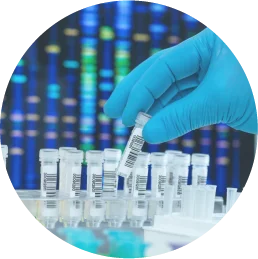Before takeoff, flight attendants tell you to “put your oxygen mask on first” in case of an emergency. They tell you to do this so that you are able to breathe and survive while helping those around you. When it comes to prostate cancer awareness and prevention, knowledge is your oxygen mask. Use this guide to learn the risk factors and what to do about them. Then help others by sharing what you know. You might just save a life. #prostatecancerawarenessmonth
All Men Are at Risk
All men are at risk for prostate cancer. Maybe that includes you, your father, your grandfather, your brother, or your son. No matter how healthy, happy, wealthy, or wise, prostate cancer doesn’t discriminate, no matter how much we love and care for the men in our lives.
An estimated one in eight men will be diagnosed with prostate cancer in their lifetimes. It is essential for every man to get to know their personal risk factors. They say the best defense is a good offense, and a good offense always has a strategy. If you or a loved one has yet to put a prostate cancer prevention plan in place, there’s no time to start like the present.
This September, we’re helping you get your game plan together. In honor of Prostate Cancer Awareness Month, start with self-awareness. (Then encourage other men to do the same!) Early detection not only saves lives but gives you treatment options. The longer you wait the fewer choices you have.
Age, Genetics, and Ethnicity
Age, genetics, and ethnicity are the three main risk factors for men developing prostate cancer. The older a man gets, the more his chances of developing prostate cancer increase.
For context, consider the odds:
In men aged fifty to fifty-nine, the risk of developing prostate cancer is 1 in 52. In men seventy years or older, it’s 1 in 11.
Falling just in the middle of this trend is the age at which about fifty percent of all prostate cancers in the US are diagnosed, which is 66 years old[i].
While older men have a notably higher risk of developing prostate cancer, men in their forties are not immune from getting the disease where genetics and family history play a role. Prostate cancer falls into 3 categories: sporadic, familial, and hereditary. Know your family story.

Sporadic prostate cancer accounts for the majority of all cases. Disease in these men develops by chance, usually in one or two men in a family, typically at older ages.
About 25 percent of men have familial cancer, colloquially referred to as a “family history” of the disease. Researchers believe familial cancer may be due to genetics or other shared factors, like environment and lifestyle. If you have at least one first-degree relative, such as a father, brother, or son who develops the disease, you may be at an increased risk. If this is the case, be sure to tell your doctor. They may recommend beginning preventative screenings earlier.
Five to ten percent of men have hereditary prostate cancer. Men in this cohort were born with certain gene mutations that other men with prostate cancer develop over time. Given this unlucky head-start, their risk is double that of the average man. Furthermore, the disease is typically earlier on-set (occurring before the age of 55), and tends to manifest in more aggressive, or malignant forms.
Hereditary prostate cancer may run in your family if you have any of the following:
- At least three close relatives, such as a father and two brothers, affected
- Two close relatives who were younger than 55-years-old when diagnosed
- Three generations of relatives (a grandfather, father, and brother) affected
- A family history of prostate cancer coupled with breast, ovarian, colon, or pancreatic cancer
In these cases, the National Comprehensive Cancer Network (NCCN) guidelines recommend you have a yearly digital rectal exam (DRE) and a yearly prostate-specific antigen (PSA) blood test beginning at age 40.
Additionally, you may want to talk with your doctor about undergoing genomic testing. Scientists say mutations found predominately in the BRCA1, BRCA2, and HOXB13 genes are key culprits in the development of prostate cancer.
HALO Diagnostics (Dx) offers genomic tests to analyze and detect the presence of these and other mutations using either a blood or urine sample
Ethnicity is another important factor – Men of African and Caribbean ancestry are:
- More likely to get prostate cancer than other men
- More likely to develop the disease at a younger age
- More likely to get more aggressive forms of the disease
- More than twice as likely to die from it than other men
The NCCN recommends that men of African and Caribbean descent also start screening for prostate cancer at the age of 40 with yearly PSA tests and DREs.
Know Your PSA Number
The prostate creates a protein called prostate-specific antigen, or PSA. Your PSA can be measured by a simple blood test and is typically the first step in preventative prostate cancer screening. It’s important to establish a baseline PSA when you begin testing and keep track of changes over time. The test cannot diagnose prostate cancer but results showing a steady or sharp increase in your PSA should be considered cause to escalate screening to the next level.
When to get a PSA test? The American Urological Association (AUA) recommends:
- Men under 40: No screening – there is no evidence to suggest a benefit of screening under 40
- Men aged between 40 to 54: No screening if you’re at average risk. If you’re at high risk (such as having a family history of prostate cancer), the decision should be made by yourself and your doctor.
- Men aged between 55 to 69: Screening with doctor approval. This is the age group is identified as having the greatest benefit of screening.
- Men aged more than 70 or having a less than 10 to 15-year life expectancy: Routine screening is not recommended unless you are in excellent health and may benefit from screening.
Recommendations among various other national cancer institutions differ as to when various cohorts of men should begin PSA testing. Ultimately, you should consult with your doctor when deciding on a screening plan that is best for you based on personal health and risk factors.
Know Your Advanced Screening Options
In the past, doctors typically referred men with an elevated PSA and/or an abnormal digital rectal examination to undergo a prostate biopsy. Today, this is not a course of action recommended by the American Urological Association or the NCCN. Both institutions now recommend men get a multiparametric prostate MRI (mpMRI) before moving ahead with a prostate biopsy. A prostate mpMRI is non-invasive and produces multifocal, or multidimensional views of the prostate.
The doctors and clinicians at HALO Diagnostics (Dx) specialize in interpreting prostate mpMRI images. If you’ve recently had a prostate mpMRI screening and are seeking a second opinion or are exploring prostate cancer treatment options, schedule a consultation today by clicking below. Fill out our consultation request form and be sure to include any details you’d like us to know. A member of our team will contact you to discuss your specific case. Every individual is unique and at HALO Dx we provide a personalized and precision-focused approach to the diagnostics and treatment of each patient.
Be Aware: There is Hope!
Prostate cancer can be a serious disease, but most men diagnosed with prostate cancer do not die from it. In fact, more than 3.1 million men in the United States who have been diagnosed with prostate cancer at some point are still alive today[ii].
Are you worried about prostate cancer? Is there a family history? If you are concerned about, diagnosed with, or worried about someone close, don’t wait! This September, use awareness to facilitate action and know that the HALO Dx team is here to help.
To learn more about the HALO Dx men’s health screening and diagnostics program, call 760-469-8057.
You should always consult with your doctor(s) when considering treatment options. HALO Dx provides MRI-guided prostate screenings, MRI-guided prostate biopsy, liquid “biopsy” tests, and genomic testing to facilitate informed decisions between doctors and patients. Learn more about HALO Dx’s advanced, minimally invasive prostate cancer and BPH treatments including Laser Focal Therapy and TULSA-PRO for whole gland and partial ablations. With the appropriate diagnostic results, our prostate disease experts help you answer any questions you may have about prostate cancer, BPH.
Article references:
[i] American Cancer Society. Facts & Figures 2021. American Cancer Society. Atlanta, Ga. 2021.
[ii] https://www.cancer.org/cancer/prostate-cancer/about/key-statistics.html




